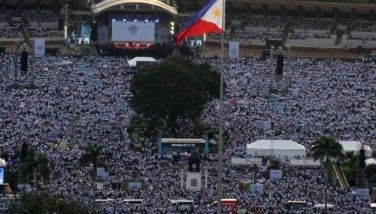Rules for hooligans
One of the big stories this week revolves around the actions of Rain or Shine big man Beau Belga and his actions deemed unfit for a professional athlete. Belga has since publicly apologized for his unsportsmanlike acts on the basketball court, but it begs the question: what can be done to prevent similar occurrences in the future? What rules can be implemented for the mutual protection and enjoyment of the game for both fans and athletes?
One of the worst (and probably most forgotten) cases of violence in the history of the PBA took place on April 9, 1977. Crispa made a late fourth-quarter comeback and stole an opening-day victory from Toyota at the Araneta Coliseum. As we all know, there is only one tunnel leading to the locker rooms at The Big Dome. In those days, teams exited the playing court simultaneously, which can lead to some incendiary situations. Some teasing led to a free-for-all. Varying accounts of the aftermath say that the following day, both teams were summoned from practice to Metropolitan Command headquarters at Camp Crame, where they faced an irate Metrocom chief in Gen. Prospero Olivas.
“You shouldn’t have behaved that way,” Olivas was quoted as saying to the players from both teams seated on opposite sides of a long conference table, “you’re setting a bad example for our youth. This is the New Society. Do you know that I could have you jailed?”
The players snickered in response. Olivas was enraged, and summoned six officers to take the players’ fingerprints, booking them like common criminals. They were then herded onto a Metrocom bus, and spent the night as guests of the state at Fort Bonifacio. They were released early the next morning, and each fined P1,000.
More recently, guard Wynne Arboleda attacked a fan whom he claimed had been using foul language against him during an entire game against Smart Gilas in 2009. Even more recently, Ateneo de Manila head basketball coach Bo Perasol was suspended after going after a De La Salle fan who had been haranguing him after an embarrassing loss to the Green Archers at Araneta.
There are usually two components in bad player behavior: a tense situation on the court, and harsh fan behavior around it. Let’s tackle the latter first. In Europe, much hooliganism is perpetrated by football fans. Many team and police authorities there have taken varying steps to prevent violence from emanating from fans, who sometimes use the occasion to push political and racist agendas. Just yesterday, France gave the police broader powers in dealing with fan violence. This came after a brawl in August left 44 policemen injured before and after a match in Corsica, The Daily Mail reported. In the United Kingdom, Liverpool FC clearly states this on their website. “If someone in the stadium is in violation of the ground regulations or commits a public order offense under a criminal act, then they will face arrest. Subject to the outcome of the arrest, they could face a ban from the stadium... For fans unsure about what they can and cannot bring into Anfield, there is a strict policy: offensive weapons such as knives, fireworks, firearms, bottles, cans and alcohol are not allowed inside Anfield.”
After several serious outbreaks of fighting took place in 2011, German authorities decided to impose stiffer penalties on hooligans the following season, including a three- to 10-year bans. The low point was the end of a match in May of 2011 between second division squad Karlsruhe and third division team Ratisbon, where a melee left 75 people injured, including 18 police officers. German football teams were also required to increase security expenditure by 50 percent. Meanwhile, the government of Switzerland, after 10 round-table discussions, kicked the problem over to the different states and football clubs, while some football authorities there complained of proposed cookie-cutter solutions that they claimed would not work everywhere.
Russia, for its part, implemented a new “Fans Law” in January of 2014. The measure included bans, heavy fines and even incarceration for violators, although responsibility was placed on the shoulders of event organizers. The law prohibits spectators from bringing pyrotechnics, coloring substances, any signs of a political, Nazi, extremist or provocative nature, into stadiums. Fans are also not allowed to wear masks to hide their faces. It also restricts placards with insults or obscene images. Signs in foreign languages must have translations that are notarized or otherwise approved by the event organizers. A match in 2012 was left unfinished because fans had thrown smoke grenades onto the playing field.
In some leagues, water bottle are not allowed inside the venue, or their caps are confiscated so that they may not be turned into missiles. Over the past 29 years, this writer has ben hit by coins, spark plugs, ball bearings, plastic cups, water bottles, cardboard fans, spit, sticks, toilet paper and other debris while doing commentary at various sporting events.
Now let’s talk about player behavior. Many basketball fans are aware of past basketball brawls in the NBA, PBA, UAAP, NCAA and even the occasional football scuffle. Hockey has its penalty box, and rugby has rules sending off a player for misbehaving. For fans, there are some simple guidelines for spotting and analyzing boorish actions during play.
First, once the whistle blows to halt action, any contact with a player from the opposing team is obviously not allowed, this rule even applies to boxing and mixed martial arts, so it’s clearly a serious offense to do so.
Simply put, your defenses are down. Secondly, any attempt to strike a player above the shoulders (particularly in basketball) is considered a severe infraction, whether you use your hands, head or even the ball. This rule was implemented in the Philippines first by the defunct Metropolitan Basketball Association, which used video review to find and punish even unsuccessful attempts to hit another player from the neck up.
Third, unnatural movements during a game are obviously forbidden. This includes using closed fists, grabbing another player, striking, tripping, undercutting, kicking, excessive bumping, clotheslining, choking and other actions that are obviously harmful. Spitting at another player is considered particularly vile. Players always claim that their intentions are honest, but these actions are not part of the integral motion of playing the game.
- Latest
- Trending






























